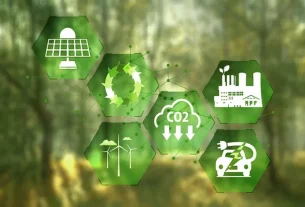In a historic move towards a greener future, China has passed its first-ever energy law, a landmark piece of legislation aimed at promoting carbon neutrality and addressing energy challenges for the coming decades. The law, which was adopted by the Standing Committee of the National People’s Congress (NPC), will take effect on January 1, 2025, signaling a bold step in China’s strategy to tackle climate change and transition towards a low-carbon economy.
The passage of the Energy Law of the People’s Republic of China marks a pivotal moment in the country’s climate policy. It aligns with President Xi Jinping’s vision of achieving carbon neutrality by 2060 and a peaking of carbon emissions before 2030, both key elements of China’s broader environmental goals. With the new law, China is aiming to integrate sustainable energy development into the fabric of its national growth and economy.
A Comprehensive Approach to Energy Reform
The energy law is a comprehensive document that touches on a wide range of critical energy issues, from planning and development to market systems and emergency response. Divided into nine chapters, the law addresses the following core areas:
- Energy Planning: The law outlines China’s long-term energy strategy, focusing on efficient energy use, diversification, and transitioning towards renewable sources like solar, wind, and hydropower. It calls for a well-organized national framework for energy planning and aligns with the country’s broader green growth goals.
- Energy Market Reform: The legislation aims to reform energy markets to encourage greater competition, attract investment, and reduce inefficiencies in the energy sector. It emphasizes the role of market forces in driving energy efficiency and sustainability, while also ensuring fair competition and transparent pricing.
- Energy Development and Innovation: The law stresses the importance of technological innovation, particularly in the areas of clean energy and energy storage. It calls for continued investment in research and development to advance China’s energy sector and reduce reliance on fossil fuels.
- Environmental Protection: A significant focus of the law is on reducing the environmental impact of China’s energy sector. This includes emissions reductions, air pollution control, and improving the overall environmental performance of energy production and consumption.
- Energy Security and Emergency Response: Recognizing the vulnerabilities in energy supply chains, the law outlines strategies for improving energy security and ensuring the stability of energy markets during crises. This includes provisions for emergency response measures in the event of energy shortages or supply disruptions.
- Carbon Emissions and Climate Goals: The law aligns China’s energy strategy with its broader climate commitments, particularly the ambition to achieve carbon neutrality by 2060 and to peak carbon emissions before 2030. It calls for the gradual phase-out of high-carbon energy sources and greater investment in green technologies.
- Promotion of Energy Efficiency: The law encourages the adoption of energy-efficient technologies and sets targets for reducing energy consumption per unit of GDP, aiming to decouple economic growth from energy use.
- Social and Economic Equity: The legislation also emphasizes the need for a just transition to a sustainable energy future, ensuring that the benefits of clean energy development are shared broadly across society and that vulnerable populations are not left behind.
A Step Toward Carbon Neutrality
China’s new energy law underscores its commitment to achieving carbon neutrality by 2060, a target set by President Xi in 2020. The country, the world’s largest emitter of greenhouse gases, faces a significant challenge in reducing its carbon footprint while continuing its rapid economic development.
The law outlines a roadmap for transitioning from fossil fuels, such as coal and oil, to renewable sources of energy. Over the next few decades, China is expected to invest heavily in renewable energy infrastructure, including solar power, wind energy, and nuclear power, while also developing electric vehicles (EVs) and battery storage technologies to reduce its dependence on fossil fuels.
The law also sets the stage for China’s efforts to meet its international climate obligations, such as those under the Paris Agreement, which calls for a global effort to limit global warming to below 2°C, with an emphasis on reaching net-zero emissions by 2050 or sooner.
China’s Green Ambition: Challenges and Opportunities
China’s new energy law is not just an effort to reduce carbon emissions—it is also part of the country’s broader goal to lead in the green energy space. By setting ambitious renewable energy targets, China aims to become the global leader in clean energy technology and innovation. However, the journey to carbon neutrality will not be without challenges.
Despite the rapid growth of solar and wind energy, China still relies heavily on coal, which accounts for more than half of its energy consumption. This presents a significant challenge, particularly in terms of balancing economic growth with environmental sustainability. The law acknowledges this difficulty by calling for a gradual transition, ensuring that the energy shift does not disrupt economic development or social stability.
China is also facing challenges in modernizing its energy infrastructure to accommodate the expansion of renewable energy and electric vehicles. Investments will be needed in energy storage systems, smart grids, and electric vehicle charging stations to facilitate the clean energy transition.
Global Implications and Leadership
The passage of China’s energy law is expected to have far-reaching implications for global energy markets. As the world’s largest energy consumer and a major player in international trade, China’s policies will shape the future of energy supply and demand across the globe. The country’s push for low-carbon technologies could accelerate the global energy transition, creating opportunities for international cooperation in the development and deployment of renewable energy.
Moreover, the law could help China strengthen its position as a leader in climate diplomacy and green technology innovation. As countries around the world seek to meet their own climate goals, China’s experience in balancing economic growth with environmental sustainability could serve as a valuable model for other nations.
Conclusion: A Bold Step Toward a Sustainable Future
The passage of China’s first-ever energy law is a major step toward the country’s ambitious climate goals, particularly its target of carbon neutrality by 2060. The law provides a clear framework for the transition to a more sustainable energy system, balancing economic growth with environmental responsibility.
As the world’s largest emitter of greenhouse gases, China’s leadership in this area will be crucial in meeting global climate targets. The law’s focus on green energy innovation, energy efficiency, and carbon emissions reduction signals China’s determination to move toward a low-carbon future. The successful implementation of this energy strategy will be critical to addressing the global climate crisis and shaping the future of the global energy market.
References:
- China Daily – China’s Energy Law to Promote Green Transition and Carbon Neutrality
Source: China Daily - Reuters – China Passes Historic Energy Law to Promote Sustainable Development
Source: Reuters - BBC News – China’s Energy Law and Its Implications for Global Climate Goals
Source: BBC - The New York Times – China’s Path to Carbon Neutrality: A Comprehensive Energy Strategy
Source: NYT


